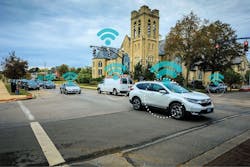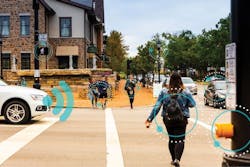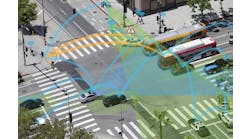By: Lori Duguid, P.E., PTOE
Since its inception more than 60 years ago, the nation’s interstate transportation system has successfully connected the country from coast to coast, improving the quality of life for many Americans and advancing the economy.
However, with this achievement has come challenges: safety issues, lost time and money while being stuck in traffic, and environmental impacts, to name just a few.
Until recently, using the next generation of intelligent transportation systems (ITS), or a network of technology deployments that focus on both the infrastructure and vehicle, as well as integrated applications between the two, seemed like something straight out of a sci-fi movie set in the distant future. But in Ohio, the future is now, and the 33 Smart Mobility Corridor is leading the way.
The 33 Smart Mobility Corridor is a 35-mile divided highway corridor just northwest of Columbus, Ohio. The corridor is a part of the Columbus region smart mobility ecosystem, crossing three counties (Franklin, Union, and Logan) and connecting the cities of Marysville and Dublin to Honda’s North American Campus, as well as the 540-acre SMART Center at the Transportation Research Center (TRC), and points beyond. It is home to one of the largest concentrations of manufacturers, research and development firms, and logistics companies in Ohio, and provides an environment for closed and open testing in all weather conditions in rural, exurban, and urban environments. The corridor’s smart mobility network will support the future growth of its current mobility companies, while encouraging new companies to consider the 33 Smart Mobility Corridor for expansion.
Smart transportation
In the U.S., there is increasing emphasis on creating a smart transportation network that is safer, more efficient, less expensive, and largely automated. The Columbus region initiative sets out to do just that. Since 2016, more than $600 million has been pledged by public and private partners to advance smart technology in the region, including initiatives such as Smart Columbus, the TRC SMART Center, Connected Marysville, Connected Dublin, and the 33 Smart Mobility Corridor.
The 33 Smart Mobility Corridor project kicked off in 2014 with the formation of a collaborative group tasked with exploring development issues along U.S. 33 and will continue in 2020 and beyond with the 33 Smart Mobility connected vehicle environment (CVE) being fully operational. In 2016, the local governments of the city of Marysville, the city of Dublin, Union County, and the Marysville-Union County Port Authority formed a Council of Governments—the NW 33 Innovation Corridor Council of Governments (COG)—to oversee and manage the development along the U.S. 33 corridor.
In 2017, the NW 33 Council of Governments was awarded a $6 million Advanced Transportation and Congestion Management Technologies Deployment (ATCMTD) grant to implement connected vehicle technologies along the 33 Smart Mobility Corridor. Along with the COG, DriveOhio and the Ohio DOT (ODOT) contributed additional funds needed to support the local match required to implement the federal grant. Michael Baker International is providing program management and technical oversight for the administration of the grant projects. The major components include:
- Construction of the local loop redundant fiber network.
- Deployment of vehicle-to-infrastructure technology using dedicated short-range communication (DSRC) in the form of roadside units (RSUs).
- Deployment of vehicles equipped with on-board units (OBUs) to receive and transmit messages to RSUs using DSRC.
- Development and deployment of connected vehicle (CV) safety applications, including pedestrian crosswalk warnings to inform drivers of pedestrian presence, reduced speed zones and lane closure warnings to inform drivers of unexpected conditions, red-light violation warnings to inform drivers of potential collisions, and curve speed warnings at interchange ramps to inform drivers of high-speed approaches.
- Deployment of an operating and data network to support all aspects of the CVE, monitor the health and status of RSUs, send/receive data obtained through RSUs and OBUs, and facilitate firmware and security certification updates.
Smart mobility
The corridor is a key component of Ohio’s new Smart Mobility Initiative, which is being led by DriveOhio and ODOT. Supported by ODOT, DriveOhio works to ensure Ohio’s regulatory environment and public policies are conducive to the development of the infrastructure and technologies needed for smart mobility. Simply put, DriveOhio is committed to advancing smart mobility in Ohio and being a one-stop shop for those looking to develop, test, and deploy advanced mobility solutions in Ohio.
This fully connected corridor in central Ohio establishes a critical link between Smart Columbus and TRC, creating a smart ecosystem. The TRC is the nation’s largest independent proving grounds. A world-renowned testing facility, the TRC has 4,500 acres of road courses and a 7.5-mile test track. This testing playground is designed to test and validate nearly any vehicle imaginable, any time of the year. It is home to the National Highway Traffic Safety Administration (NHTSA) Vehicle Research and Test Center, the only federal vehicle test laboratory in the nation. This facility is leading the evolution of connected and autonomous vehicles into the future and the key proximity of the TRC to the 33 Smart Mobility Corridor will allow for seamless off-road and on-road testing of connected vehicle technology.
There are currently 184 smart intersections in development throughout the Columbus region: 147 in Columbus, 27 in Marysville, and 10 in Dublin, as well as thousands of vehicles planned for deployment with OBUs.
Fiber collaborative
Recognizing the need for “anywhere and everywhere” connectivity, the 33 Corridor Fiber Collaborative is designed to offer multiple options for high-speed and redundant fiber optic service for users that require the movement of large amounts of data across multiple platforms. With this collaborative, 432 strands of redundant fiber provide businesses along the U.S. 33 corridor access to the level of reliability, speed, and power that they need to remain a major player in the highly competitive global marketplace. Thirty-nine miles of 432-strand fiber optic cable was installed by ODOT along the corridor as Phase 1, completed in 2017. Phase 2 is nearing completion and will add a 42-mile redundant loop of fiber along Industrial Parkway and throughout the respective cities. This fiber serves as a communications backbone to the corridor. The COG is a contributing member of the 33 Corridor Fiber Collaborative, which was started by ODOT and now is led by DriveOhio.
Connectivity throughout
The 33 Smart Mobility Corridor will provide complete connectivity. Sixty-one RSUs will be installed along U.S. 33 that will provide continuous coverage of DSRC along the corridor from Dublin, through Marysville, terminating in East Liberty at the TRC. The 33 Smart Mobility Corridor houses two important testing grounds: Connected Marysville and Connected Dublin. The city of Marysville provides the opportunity to test within a small town with lower traffic volumes. Connected Marysville includes 27 traffic signals outfitted with RSUs.
Connected Dublin provides a suburban environment with unique mobility opportunities to innovate. Dublin provides coordinated signalized corridors, roundabouts of varying configurations, concentrated pedestrian areas, and multimodal and parking technology opportunities. As part of the ATCMTD grant project, portions of the Avery-Muirfield Corridor and the Bridge Street corridor are equipped with RSUs.
Combining technology and infrastructure
The 33 Smart Mobility Corridor project itself is at the forefront of current technology; however, technology is constantly evolving. A major challenge is not knowing what future technology will be used by the infrastructure being built today and what the needs of that technology will be. For example, when putting up poles, it is almost impossible to predict how high from the ground future technology will need to be, what kind of communications backhaul will be required, or even how much power will be needed. To account for future technologies, the team imagines the universe of what could be and incorporates aspects of that universe into the design in the most cost-effective manner possible.
The height requirements are known to optimize the use of DSRC with RSUs currently available, which requires the unit to be placed approximately 25 ft above the roadway surface. To accommodate the unknown future, the project is using a mixture of 50-ft and 40-ft aluminum poles with transformer bases. These specifications ensure that the installed infrastructure has a useful lifespan to support future technology needs, but the team also had to consider costs and attempt to utilize products that were readily available and met standard highway safety criteria.
ITS cabinets were handled very similarly. Overdesigning and incurring unnecessary costs were concerns, but there needed to be flexibility to adapt to future needs. For the project, a mix of pole-mounted cabinets for the 40-ft poles and ground-mounted ITS cabinets for the 50-ft poles were specified. A construction contract was awarded to J Ranck Electric Inc., for installation of the infrastructure to support the RSUs along the corridor in late August 2019, and this construction is anticipated to be complete by the end of July 2020.
Continuous DSRC coverage along U.S. 33, a desire by the COG to provide continuous testing along the corridor, requires a very specific spacing of RSUs to meet the coverage requirements. For this reason, the locations could not be based on proximity to existing power service. To provide direct power to each of the RSU locations, significant right-of-way easement purchases would have been required, which would have cost both time and money. The project team worked very closely with the four power companies that provide service throughout the corridor to determine a solution that would meet the known needs and minimize cost as much as possible. The final configuration resulted in primary power being provided in select locations that were accessible to the power companies and then multiple RSUs being serviced from those locations; some locations will have 30-Amp service while others are limited to 15-Amp.
An RSU integrator team, led by M.H. Corbin LLC, was selected during the summer of 2019 to complete the systems engineering documentation, procure, configure, and test the RSUs, both along U.S. 33 and at the traffic signals in Marysville and Dublin. City forces will handle installation of the RSUs at the traffic signals, and the construction contractor will install them along U.S. 33. A goal of the project has been to ensure interoperability between devices, so a requirement of the RSU integrator was to procure multiple types of RSUs for the deployment. Both Danlaw and Kapsch RSUs are being installed along the corridor and at the traffic signals. The locations were chosen so that each type of RSU will be paired with each controller type in the two cities. The RSUs at the traffic signals will be operational (as of this writing) by the start of 2020.
Challenges & looking ahead
The technology that is being deployed on projects like this is somewhat new for infrastructure owners and is expected to present its own range of challenges. An unexpected consequence has been determining and meeting the infrastructure needs required to support the technology. Subsequent deployments will benefit from the lessons that are being learned on this project.
This project includes a large number of stakeholders and requires collaboration across agencies and jurisdictions. Since Ohio is a home rule state, to implement a project of this size, multiple infrastructure owners are involved and crucial in decision-making as the project needs to demonstrate interoperability. Early on, it became evident that it would be critical to establish a decision-making process amongst this large and diverse group with representatives from Dublin, Marysville, Union County, ODOT, and DriveOhio. In addition, the team realized the need for frequent and open communication to ensure each stakeholder’s needs continue being met throughout the course of the project.
Another challenge is defining use cases when technology changes so rapidly. Here the key is finding a balance between creating an appealing proposition for new businesses to choose the corridor and provide economic development, specifically as a testing ground for new CV technologies, while simultaneously fulfilling the requirement of government agencies to provide a societal benefit (because the project uses tax dollars). In the case of the 33 Smart Mobility Corridor, the team identified use cases pertaining to safety and easing traffic congestion while also building a sustainable business model encouraging private sector investment.
During the next year, the project will move forward with the development of safety applications that will be deployed on fleet vehicles, and standing up a network that will tie into the fiber optic that is installed along the corridor to generate and receive data, as well as provide monitoring of the system.
As autonomous and connected vehicle research expands throughout the state, with the 33 Smart Mobility Corridor at the forefront, Ohio is set to become a centerpiece of connected vehicle testing.
About The Author: Duguid is Associate Vice President and Assistant Program Manager of Emerging Technologies at Michael Baker International.



